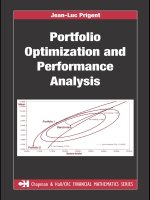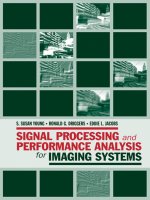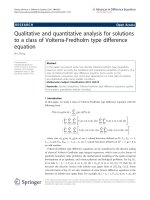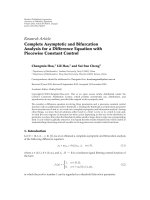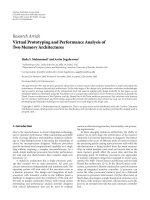Algorithms and performance analysis for indoor location tracking systems
Bạn đang xem bản rút gọn của tài liệu. Xem và tải ngay bản đầy đủ của tài liệu tại đây (8.13 MB, 127 trang )
ALGORITHMS AND PERFORMANCE
ANALYSIS FOR INDOOR LOCATION
TRACKING SYSTEMS
YUNYE JIN
(B. ENG. (Hons.), NUS)
A THESIS SUBMITTED FOR THE DEGREE OF
DOCTOR OF PHILOSOPHY
DEPARTMENT OF ELECTRICAL AND COMPUTER ENGINEERING
NATIONAL UNIVERSITY OF SINGAPORE
2011
To my parents.
i
Acknowledgements
I would like to express my heartfelt gratitude to my supervisor, Prof. Soh
Wee-Seng, for his continuous guidance and support during my Ph. D. candidature.
His insights, knowledge, patience, and enthusiasm have provided great inspirations
and set an admirable example for me. He has generously devoted his time and
efforts to this thesis, without which its completion would not be possible.
I would like to express my utmost appreciation to my co-supervisor, Prof.
Wong Wai-Choong, Lawrence, for always providing me with motivational thoughts
and ideas during our discussions. His experience and expertise across various fields
have broaden my persp ective and extended my dimensions of thinking.
My sincere thanks also goes to Prof. Mehul Motani, for not only his teaching
as my lecturer of the computer networks module, but also the collaborations and
discussions we had during several research projects and demos, which have greatly
benefited me.
I am grateful to Prof. Hari Krishna Garg and Prof. Marc Andre Armand, for
their time and efforts in assessing my research work, for the valuable suggestions
and critical questions during my qualification examination.
I must thank NUS for financially supporting my study and research through
the NUS Research Scholarship.
I am deeply indebted to my parents back in China, who have never lost faith
ii
ACKNOWLEDGEMENTS
in me. They have always been there for me with their love and care, during the
ups and downs of the past four years.
I would like to thank the lab officers, Mr. Song Xianlin, Mr. Goh Thiam
Pheng, and Mr. Siow Hong Lin, Eric, for their help and assistance during all my
research projects.
Last but not least, I would like to thank all my colleagues and lab mates in
NUS ECE Communications Lab and IDMI Ambient Intelligence Lab.
iii
Summary
The ability to accurately track a user’s location in the indoor environment has
many applications in the healthcare, logistic, and entertainment industries. This
thesis makes a threefold contribution to the realization and analysis of practical
indoor location tracking systems.
First, we propose an efficient channel-impulse-response-based (CIR-based)
location fingerprint, derived from receiver channel estimation results. Logarithmic
transformation is applied to ensure that each element in the fingerprint vector
contributes fairly towards the location estimation. Simulation results show that,
with the same number of access points and the same amount of training efforts, the
proposed method significantly outperforms the existing fingerprint-based methods
in the literature. It is also robust to the environmental changes caused by the
presence of a crowd of human bodies.
Second, we derive the exact theoretical expressions of both the online error
probability density function (PDF) and region of confidence (RoC) for a general-
ized location fingerprinting system. Computations of both terms require the joint
PDF for the location and the online signal parameter vector, which is practically
unknown. We therefore propose to approximate this joint PDF by nonparametric
kernel density estimation using the training fingerprints, without extra calibration
efforts. Experimental results show that, the proposed scheme predicts the empir-
iv
SUMMARY
ical error PDF closely for the two most popular location fingerprinting methods,
namely, the K nearest neighbour (KNN) and the probabilistic approach.
The third contribution includes two different approaches that we propose to
realize a robust pedestrian tracking system using mobile devices with low cost sen-
sors. The first approach fuses the estimates of a dead-reckoning (DR) system with
the measurements of a sparsely deployed ranging infrastructure, using a particle
filter (PF). Experimental results show that this approach significantly reduces DR
tracking error even when (i) initial location is unknown, (ii) range measurements
have errors, (iii) range updates are intermittent and sparse both temporally and
spatially. The second approach fuses the estimates of two DR modules, carried
by the same pedestrian and mounted with stable relative displacement, through
a maximum a posteriori estimation scheme. Experimental results show that, the
proposed scheme delivers robust tracking performance, with significantly smaller
average error compared to traditional DR methods, when using (i) two DR mod-
ules, each with a single orientation sensor and arbitrary device orientation, (ii) one
DR module, with two different orientation sensors and fixed device orientation.
v
Contents
Dedication i
Acknowledgements ii
Summary iv
Contents vi
List of Figures xi
List of Tables xiv
List of Symbols xv
1 Introduction 1
1.1 Background . . . . . . . . . . . . . . . . . . . . . . . . . . . . . . . 1
1.2 Overview of Existing Indoor Location Tracking Systems . . . . . . . 2
1.2.1 Methods Based on Dedicated Infrastructure . . . . . . . . . 2
1.2.2 Methods Based on The Existing Infrastructure . . . . . . . . 3
1.2.3 The Dead-Reckoning Approach . . . . . . . . . . . . . . . . 4
1.3 Research Emphasis and Contributions . . . . . . . . . . . . . . . . 5
1.3.1 Channel Impulse Response Based Fingerprinting . . . . . . . 5
vi
CONTENTS
1.3.2 Error Analysis of Fingerprint-based Methods . . . . . . . . . 6
1.3.3 Robust DR-Based Pedestrian Tracking Methods . . . . . . . 6
1.4 Organization of the Thesis . . . . . . . . . . . . . . . . . . . . . . . 8
2 Literature Review 9
2.1 The Geometric Approach . . . . . . . . . . . . . . . . . . . . . . . . 9
2.1.1 DoA Based Methods . . . . . . . . . . . . . . . . . . . . . . 9
2.1.2 ToA and TDoA Based Methods . . . . . . . . . . . . . . . . 11
2.1.3 The Non-Line-of-Sight Problem . . . . . . . . . . . . . . . . 12
2.2 The Fingerprint-based Approach . . . . . . . . . . . . . . . . . . . 13
2.2.1 Algorithms . . . . . . . . . . . . . . . . . . . . . . . . . . . 13
2.2.2 Performance Analysis . . . . . . . . . . . . . . . . . . . . . . 14
2.3 The DR based Approach . . . . . . . . . . . . . . . . . . . . . . . . 15
2.4 The Hybrid Approach . . . . . . . . . . . . . . . . . . . . . . . . . 17
3 Channel Impulse Response Based Location Fingerprinting 18
3.1 The Channel Impulse Response Based Fingerprint . . . . . . . . . . 19
3.2 System Implementation Issues . . . . . . . . . . . . . . . . . . . . . 20
3.3 Localization by Nonparametric Kernel Regression . . . . . . . . . . 21
3.3.1 Low-Pass Smoothing . . . . . . . . . . . . . . . . . . . . . . 24
3.3.2 Logarithmic Scale Transformation . . . . . . . . . . . . . . . 25
3.4 Simulations and Discussions . . . . . . . . . . . . . . . . . . . . . . 28
3.4.1 Performance with Varying System Bandwidth . . . . . . . . 30
3.4.2 Cumulative Error Distribution . . . . . . . . . . . . . . . . . 31
3.4.3 Effect of Varying Training Location Density . . . . . . . . . 32
3.4.4 Effect of Varying the Number of Access Points . . . . . . . 33
3.4.5 Effect of Real Time Variation in Environment . . . . . . . . 34
vii
CONTENTS
3.4.6 Computation Time . . . . . . . . . . . . . . . . . . . . . . . 36
4 Error Analysis for Fingerprint-based Localization 37
4.1 Nonparametric Kernel Density Estimation . . . . . . . . . . . . . . 37
4.2 Theoretical Error Performance Analysis . . . . . . . . . . . . . . . . 41
4.3 Experimental Verifications and Discussions . . . . . . . . . . . . . . 43
4.3.1 Testbed Setup and Experimental Equipments . . . . . . . . 43
4.3.2 Statistical Verification . . . . . . . . . . . . . . . . . . . . . 45
5 DR-based Robust Pedestrian Tracking with Sparse Infrastructure
Support 47
5.1 Step-based Dead Reckoning with Hand-held Mobile Device . . . . . 48
5.1.1 Step Detection . . . . . . . . . . . . . . . . . . . . . . . . . 49
5.1.2 Stride Length Estimation . . . . . . . . . . . . . . . . . . . 50
5.1.3 Step Parameter Calibration . . . . . . . . . . . . . . . . . . 50
5.1.4 From Magnetometer to Digital Compass . . . . . . . . . . . 51
5.2 The Ranging Infrastructure . . . . . . . . . . . . . . . . . . . . . . 51
5.3 The Value of Sparse Information . . . . . . . . . . . . . . . . . . . . 52
5.4 System Architecture . . . . . . . . . . . . . . . . . . . . . . . . . . 54
5.5 Statistical Characterization . . . . . . . . . . . . . . . . . . . . . . 55
5.5.1 Step Estimates of the DR Sub-system . . . . . . . . . . . . . 55
5.5.2 Distance Estimates of the Ranging Sub-system . . . . . . . . 55
5.6 Fusion by Particle Filter . . . . . . . . . . . . . . . . . . . . . . . . 56
5.6.1 Initialization . . . . . . . . . . . . . . . . . . . . . . . . . . . 56
5.6.2 Importance Sampling . . . . . . . . . . . . . . . . . . . . . . 57
5.6.3 Weight Update and Resampling . . . . . . . . . . . . . . . . 58
5.6.4 Location Estimator . . . . . . . . . . . . . . . . . . . . . . . 59
viii
CONTENTS
5.7 Experiments and Discussions . . . . . . . . . . . . . . . . . . . . . . 59
5.7.1 Sensor Evaluation for Sub-systems . . . . . . . . . . . . . . 59
5.7.2 Experimental Setup . . . . . . . . . . . . . . . . . . . . . . . 63
5.7.3 Tracking Performance . . . . . . . . . . . . . . . . . . . . . 67
6 DR-based Robust Pedestrian Tracking with Two Sensor Modules 75
6.1 Dead Reckoning with Arbitrary Device Orientation . . . . . . . . . 76
6.1.1 Orientation Projection for Arbitrary Device Posture . . . . . 76
6.1.2 Noise Filtering . . . . . . . . . . . . . . . . . . . . . . . . . 77
6.1.3 Step Detection and Stride Length Calibration . . . . . . . . 77
6.1.4 Heading Orientation . . . . . . . . . . . . . . . . . . . . . . 78
6.2 System Architecture and Assumptions . . . . . . . . . . . . . . . . 78
6.3 The Robust Tracking Algorithm . . . . . . . . . . . . . . . . . . . . 80
6.3.1 Initialization . . . . . . . . . . . . . . . . . . . . . . . . . . . 80
6.3.2 Maximum A Posteriori Sensor Fusion . . . . . . . . . . . . . 80
6.4 The Special Case:A Single Device with Two Different Orientation
Sensors . . . . . . . . . . . . . . . . . . . . . . . . . . . . . . . . . . 87
6.5 Experiments and Discussions . . . . . . . . . . . . . . . . . . . . . . 88
6.5.1 Experimental Testbed Setup and Devices Used . . . . . . . . 88
6.5.2 System Synchronization . . . . . . . . . . . . . . . . . . . . 89
6.5.3 Ground Truth Collection . . . . . . . . . . . . . . . . . . . . 90
6.5.4 Tracking Performance . . . . . . . . . . . . . . . . . . . . . 90
7 Conclusion and Future Work 99
7.1 CIR-based Location Fingerprinting . . . . . . . . . . . . . . . . . . 99
7.2 Error Analysis for Fingerprint-based Localization Systems . . . . . 100
7.3 DR-based Robust Pedestrian Tracking . . . . . . . . . . . . . . . . 101
ix
CONTENTS
Bibliography 103
List of Publications 108
x
List of Figures
2.1 Triangulation with DoA. . . . . . . . . . . . . . . . . . . . . . . . . 10
2.2 Trilateration with ToA and TDoA. . . . . . . . . . . . . . . . . . . 11
2.3 Estimated locations and RoCs based on two different online RSS
vectors collected at the same actual location. . . . . . . . . . . . . . 15
3.1 ACIR vectors with transmitters located 1 m apart, at 60 MHz. . . . 20
3.2 Simulation testbed. . . . . . . . . . . . . . . . . . . . . . . . . . . . 21
3.3 Localization accuracy vs. system bandwidth (using only AP 1 and
AP 2). . . . . . . . . . . . . . . . . . . . . . . . . . . . . . . . . . . 31
3.4 Cumulative error probability (using only AP 1 and AP 2). . . . . . 32
3.5 Localization accuracy vs. training density (using only AP 1 and
AP 2). . . . . . . . . . . . . . . . . . . . . . . . . . . . . . . . . . . 33
3.6 Localization accuracy vs. number of APs. . . . . . . . . . . . . . . 34
3.7 Localization accuracy vs. number of people randomly placed and
oriented in the testbed (using only AP 1 and AP 2). . . . . . . . . . 35
4.1 Layout of the experimental testbed. . . . . . . . . . . . . . . . . . . 44
4.2 Comparison of predicted and empirical error CDFs. . . . . . . . . . 46
5.1 Vertical acceleration variations over time for 11 steps. . . . . . . . . 49
5.2 Snapshot of uncertainty regions at a particular time instance. . . . 53
xi
LIST OF FIGURES
5.3 The proposed system architecture. . . . . . . . . . . . . . . . . . . . 54
5.4 Difference in yaw measurements of the digital compass in walking
trials with and without the presence of metallic furniture. Note:
the vertical dash-dot lines mark the instances of detected steps. . . 61
5.5 Histograms for range measurements corresponding to 1m (left) and
2m (right) true separations. . . . . . . . . . . . . . . . . . . . . . . 62
5.6 Offset from true separation versus measured range. . . . . . . . . . 62
5.7 Experimental testbed and walking path. . . . . . . . . . . . . . . . 63
5.8 Tracking paths of DR and proposed scheme, both with and without
the knowledge of the initial location. . . . . . . . . . . . . . . . . . 67
5.9 Temporal tracking error propagation of the proposed scheme with
and without the knowledge of the initial location. . . . . . . . . . . 68
5.10 Average tracking error vs. standard deviation of errors injected into
range measurements. . . . . . . . . . . . . . . . . . . . . . . . . . . 70
5.11 Average tracking error vs. probability of accepting range measure-
ments. . . . . . . . . . . . . . . . . . . . . . . . . . . . . . . . . . . 71
5.12 Average tracking error vs. number of BNs whose range measure-
ments are accepted. . . . . . . . . . . . . . . . . . . . . . . . . . . . 72
5.13 Average tracking error vs. stride length. . . . . . . . . . . . . . . . 74
6.1 Illustration for the geometry of the solution. . . . . . . . . . . . . . 87
6.2 Experimental devices for two testing scenarios. . . . . . . . . . . . . 89
6.3 Average tracking errors before and after fusion for 10 experimental
trials for Scenario 1, using two devices, each containing one magne-
tometer as orientation sensor, mounted with arbitrary orientations. 91
6.4 Temporal error propagation before and after fusion for Trial 6. . . . 92
6.5 Tracking paths before and after fusion for Trial 6. . . . . . . . . . . 93
xii
LIST OF FIGURES
6.6 Temporal error propagation before and after fusion for Trial 7. . . . 94
6.7 Tracking paths before and after fusion for Trial 7. . . . . . . . . . . 95
6.8 Average tracking errors b efore and after fusion for 18 experimen-
tal trials for Scenario 2, using one device, containing two different
orientation sensors, mounted with fixed device orientation. . . . . . 96
6.9 Temporal error propagation before and after fusion for Trial 4. . . . 97
6.10 Temporal error propagation before and after fusion for Trial 11. . . 97
6.11 Tracking paths for two typical cases. . . . . . . . . . . . . . . . . . 98
xiii
List of Tables
3.1 Material characteristics for the testbed . . . . . . . . . . . . . . . . 29
4.1 Comparison between empirical and predicted error (in meters) . . . 46
5.1 Average error and rate of corrections of the proposed scheme with
both temporal and spatial sparsity . . . . . . . . . . . . . . . . . . 73
xiv
List of Symbols
Symbol Meaning
N
sc
number of sub-carriers in OFDM
τ
max
maximum excess delay of indoor channel
BW system bandwidth
M number of APs in the service area
i, j, k, n indices
s
i
the i
th
training fingerprint vector.
c
i
coordinates vector of the location where s
i
is collected
N
tr
number of training records
s online fingerprint vector
D dimension of a vector
R
s
sample covariance matrix of the training fingerprint vectors
c location coordinates of the target device
ˆ
c estimator for the location coordinates of the target device
E{·} expected value
f(·) probability density function
K(·) kernel function
exp (·) exponential function
xv
LIST OF SYMBOLS
Symbol Meaning
log (·) logarithm function
H bandwidth matrix
|H| determinant of the matrix H
h decimal scale training ACIR vector
g decimal scale online ACIR vector
T
s
symbol duration
z(t) the transmitted signal
|z(t)|
2
instantaneous power of the signal z(t)
a(·), b(·) channel gain due to propagation pass loss and antenna
characteristics
P
0
transmission power
P
n
received power at time instant nT
s
, considering only pass
loss and antenna characteristics
T time period over which power is being measured
d distance travelled by the signal
v
RF
propagation speed of the RF signal
G
tx
transmitter antenna gain
G
rx
receiver antenna gain
λ carrier wavelength
α(·), β(·) channel gain due to penetrations, reflections, and diffractions
Re
,
Im
real and imaginary part of the relative permittivity
u
i
concatenated vector for the i
th
fingerprint vector and the i
th
training location coordinates
u concatenated vector for the online fingerprint vector and the
target location coordinates
xvi
LIST OF SYMBOLS
Symbol Meaning
ˆ
f(·) estimation of the PDF f(·)
ω a scalar for pilot density estimation
R sample covariance matrix computed using training
records
¯
f
geometric mean of the pilot PDF estimation values
Φ sub-covariance-matrix
e vector of location error
η location error distance
γ location error angle
J Jacobian matrix
Pr probability
N
te
number of testing samples
S
te
set of testing samples
l vector of pedestrian location coordinates
ρ average stride length
θ stride orientation
∆
threshold
threshold for step detection
σ
ρ
standard deviation of the error in stride length estimate
σ
θ
standard deviation of the error in stride orientation
estimate
b
k
index of the BN from which the k
th
measurement is taken
µ
k
actual pedestrian-BN separation
σ
r
standard deviation of the error in range measurements
N
s
number of particle filter samples
xvii
LIST OF SYMBOLS
Symbol Meaning
N
k
number of steps taken between the (k − 1)
th
and the k
th
range measurements
w
j
weight of the j
th
sample
l
j
k
the j
th
sample
∝ proportional to
δ(·) Dirac-Delta function
A, B labels for two DR modules
v
i
noise vector
κ value of a uniform density
φ angle of the displacement between two DR modules
q displacement vector between two DR modules
F, Q, G temporary functions
R
A
, R
B
covariance matrices of module A and B’s location estimates
I identity matrix
xviii
Chapter 1
Introduction
1.1 Background
The ability to accurately track a user’s location in the indoor environment
has many applications in the healthcare, logistic, and entertainment industries. In
an ambient-intelligent environment, obtaining accurate user location information
not only facilitates the association of computational resource with the user but
also enables the invocation of relevant services based on the user context.
The Global Positioning System (GPS) is the dominating technology in the
market of outdoor location tracking. However, the signal of GPS is either entirely
blocked by walls and ceilings or severely deteriorated by multipath propagation
in the indoor environment. On the other hand, state-of-the-art cellular-network-
based methods typically deliver an accuracy at the scale of hundreds of meters [1],
which is unacceptable for many real-world indoor applications. Therefore, accurate
indoor location tracking must rely on other technologies and infrastructure.
The past decade has witnessed the proliferation of indoor wireless communica-
tion infrastructure and the emergence of commercially accessible personal mobile
1
CHAPTER 1. Introduction
devices with various sensors and multi-modal communication capabilities. These
advances have created new opportunities for the realization of cost-effective prac-
tical indoor location tracking systems.
1.2 Overview of Existing Indoor Location Track-
ing Systems
In this chapter, we classify the practical indoor tracking methods into three
categories according to their dependence on infrastructure, namely, methods that
rely on dedicated extra infrastructure, methods that rely on the existing infras-
tructure, and methods that rely on the target device itself (Dead-Reckoning). We
briefly introduce them with an emphasis on their limitations and difficulties.
1.2.1 Methods Based on Dedicated Infrastructure
The Radio Frequency Identification (RFID) technology has been widely used
as dedicated infrastructure for indoor location tracking, especially for autonomous
robots [2, 3]. However, such a system requires the dense installation of RFID tags
on the floor of the service area. The setup is very expensive in terms of not the
tags themselves but the labor input.
Another approach that usually requires dedicated infrastructure is the geo-
metric location tracking methods in the indoor environment. For distance based
methods such as Time-of-Arrival (ToA) and Time-Difference-of-Arrival (TDoA),
wireless technologies such as ultrasound [4], ultra-wide-band (UWB) [5], wideband
with enhanced sampling rate [6] are employed in order to provide satisfactory res-
olution in time, and hence distance measurements. However, transceivers in such
dedicated infrastructure normally covers limited range due to concerns such as
2
CHAPTER 1. Introduction
interference control and power conservation.
On the other hand, direction based practical indoor tracking methods rely
heavily on the directionality of the antenna. Directionality is achieved by either
using a multi-element antenna array [7] in conjunction with computationally in-
tensive algorithm such as MUltiple SIgnal Classification (MUSIC) [8] or a single
antenna with actuated reflector [9]. In both ways, the system cost is high in terms
of hardware and overhead.
For both distance and direction based methods, in the heavy presence of
indoor Non-Line-of-Sight (NLoS) propagation conditions, full location tracking
coverage of the indoor service area requires a huge number of such range-limited
transceivers, which further incurs high hardware cost.
1.2.2 Methods Based on The Existing Infrastructure
IEEE 802.11 (Wi-Fi) is the most widely adopted wireless communication
technology in indoor and urban environments. While providing high speed wireless
data access, it also enables the design and implementation of practical indoor
location tracking systems on top of existing infrastructure with minimum extra
interference.
Among the practical location tracking methods which utilizes the Wi-Fi in-
frastructure, a small subset adopts the geometric trilateration methods such as
ToA [
10, 11] or TDoA [6], which require extra hardware modifications or additions
to the commercially-accessible Wi-Fi adapters. On the other hand, the majority
of the practically implemented Wi-Fi based methods take the fingerprint-based
approach, which involves an off-line training phase during which the indoor Wi-Fi
received signal strength (RSS) are collected as location fingerprints in the ser-
vice area [12]. A major drawback of this approach is the heavy labor cost during
3
CHAPTER 1. Introduction
the training phase, especially for large service areas. Moreover, after the train-
ing phase is completed, this approach is vulnerable to the environmental changes,
caused by change of room layout or movement of the crowd.
1.2.3 The Dead-Reckoning Approach
More and more mobile hand-held devices are equipped with low cost MEMS
sensors, such as accelerometer, magnetometer, and gyroscope, for purposes such
as, flexible user interface orientation, navigation, gaming, and augmented reality.
Availability of such sensors has made Dead-Reckoning (DR) a preferable choice
for indoor pedestrian tracking.
The DR approach iteratively estimates the current location by adding the
estimated displacement to the previously estimated location. In contrast to the
afore-mentioned approaches, in which both the target device and the infrastruc-
ture deployment are indispensable parts of the tracking system, the DR tracking
scheme is almost self-contained in the target device alone (except for the initial-
ization phase). A major drawback of such a system is that, the errors in the
estimated displacement accumulate quickly over time because of the iterative na-
ture of estimation. Moreover, compared to using dedicated sensor modules which
are fixed at pedestrian body with convenient location and orientation (foot, or
center back of waist) for tracking, DR with hand-held device suffers more noise
and disturbance due to irregular movements and shifts of the upper bo dy and the
arm of the pedestrian.
4
CHAPTER 1. Introduction
1.3 Research Emphasis and Contributions
Based on the overview of the existing approaches, we observe that, although
the approaches based on the existing infrastructure and hand-held device have
various problems and limitations, they are still attractive options upon which
practical and robust indoor location tracking methods can be developed, owning
to their accessibility and cost-effectiveness. The research contribution of this thesis
is threefold, as described in the following sub-sections.
1.3.1 Channel Impulse Response Based Fingerprinting
In order to reduce hardware cost and RF interference, it is desirable to con-
struct a fingerprint-based localization system based on the existing indo or wireless
infrastructure, in which a small number of access points (APs) are deployed to pro-
vide communication coverage over a large area. Because each AP in such a system
contributes only one dimension to the RSS fingerprint vector, the resulting fin-
gerprint vector dimension may be too low to distinguish locations over a large
area.
In this thesis, we propose a novel location fingerprint based on the ampli-
tudes of the approximated channel impulse response (ACIR) vector. The ACIR
has much higher dimension with the same number of APs compared to the RSS
fingerprint. The high dimension and the strong location dependency have given
the ACIR higher capability to distinguish locations. We then transform the ACIR
into logarithmic scale to ensure that each element within the fingerprint vector
contributes fairly to the location estimation. Nonparametric Kernel Regression
(NKR) method with a generalized bandwidth matrix formula is applied for loca-
tion estimation. Using a realistic indoor propagation simulator, our results suggest
5
CHAPTER 1. Introduction
that the proposed fingerprint and its associated signal processing technique out-
perform other fingerprint-based schemes found in the literature, with the same
amount of training efforts, under various indoor conditions.
1.3.2 Error Analysis of Fingerprint-based Methods
Compared to the large number of proposals on fingerprint-based localization
methods, there are very few works which study the theoretical online error analy-
sis of fingerprint-based localization systems, while taking the current online RSS
vector into account.
In this thesis, we derive the exact theoretical expressions of both the online
error probability density function(PDF) and Region of Confidence (RoC), con-
ditioned on the observed online RSS vector, for a fingerprint-based localization
system. As the computations of the relevant terms require exact knowledge of
the joint PDF for the location and the online RSS vector, which is practically
not available, we approximate this joint PDF by Nonparametric Kernel Density
Estimation (NKDE) techniques using the training fingerprints, without any extra
calibration efforts. Experimental results show that the proposed method closely
predicts the performance of two widely adopted fingerprint-based schemes.
1.3.3 Robust DR-Based Pedestrian Tracking Methods
Despite the intrinsic cumulative tracking error, DR is still a very attractive
option for indoor pedestrian tracking due to the high accessibility of hand-held
mobile devices nowadays. In this thesis, we propose two robust DR-based pedes-
trian tracking methods that reduce and constrain the cumulative tracking error
for hand-held mobile devices.
6
